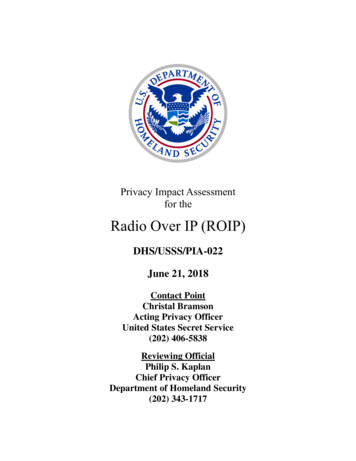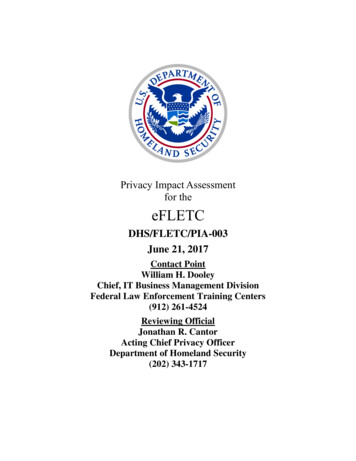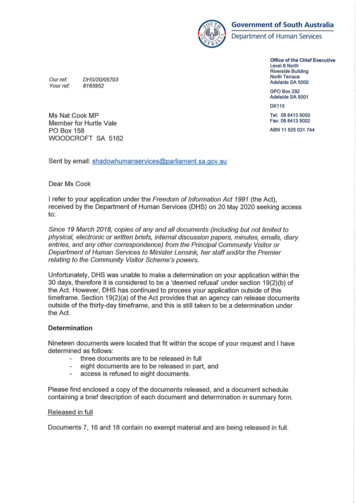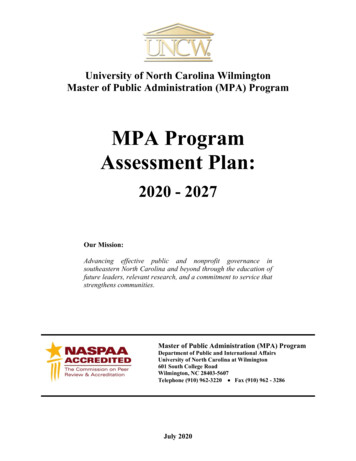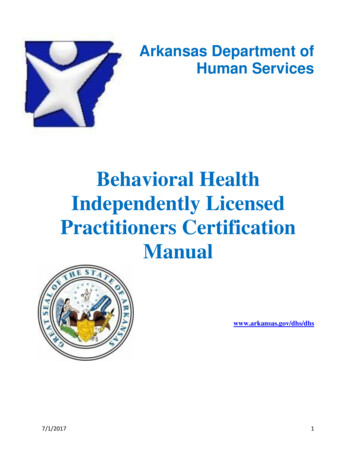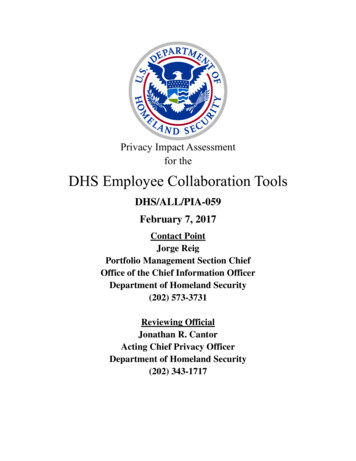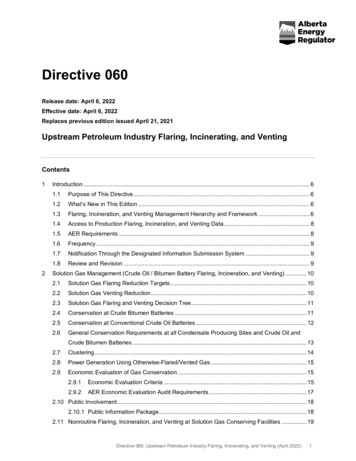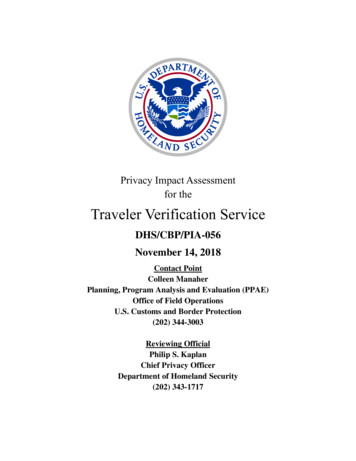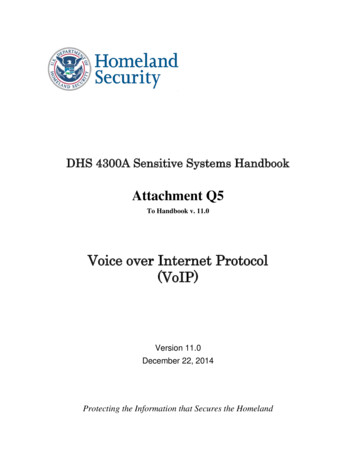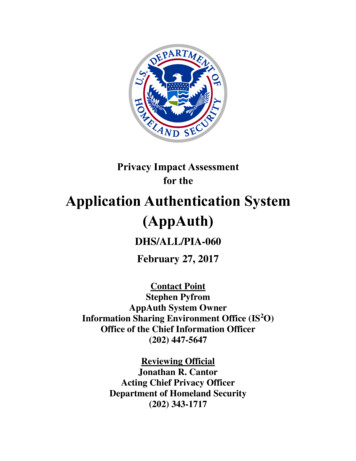
Transcription
Privacy Impact Assessmentfor theApplication Authentication System(AppAuth)DHS/ALL/PIA-060February 27, 2017Contact PointStephen PyfromAppAuth System OwnerInformation Sharing Environment Office (IS2O)Office of the Chief Information Officer(202) 447-5647Reviewing OfficialJonathan R. CantorActing Chief Privacy OfficerDepartment of Homeland Security(202) 343-1717
Privacy Impact AssessmentDHS/ALL/PIA-060 Application Authentication SystemPage 1AbstractThe Application Authentication System (AppAuth) is a Department of Homeland Security(DHS) enterprise system developed and operated by the DHS Headquarters Information Sharingand Services Office (IS2O). AppAuth is a DHS single sign-on enterprise authentication service,1which provides a uniform authentication service based on Microsoft’s Active Directory services.DHS is publishing this Privacy Impact Assessment (PIA) because AppAuth accesses and usespersonally identifiable information (PII) within the component active directory environments toadequately leverage authentication across DHS.OverviewThe Application Authentication System (AppAuth) was developed by the Department ofHomeland Security (DHS) Headquarters Information Sharing and Services Office (IS2O) tosupport its mission to deliver the services required by the DHS enterprise for mission, businessmanagement, and information technology support. AppAuth enables DHS users across theDepartment to log on to enterprise applications using their normal component login credentials.The system provides basic authorization services2 via security groups that can be establishedwithin an organization and used as the basis for internal authorization logic to determine level ofaccess for an individual user.AppAuth provides cross-domain authentication3 of DHS users for the purposes of usingDHS enterprise applications via two-way trusts.4 In a two-way “forest”5 trust relationship,AppAuth will trust a component’s active directory at the forest level6 and a component’s activedirectory will trust AppAuth. The forest allows separate active directory forests to exchangeinformation with other environments while still allowing each component active directory forestto maintain complete control over its own forest. In this model, AppAuth is the trusted domain;AppAuth allows DHS Component end users to use their current component credentials to accessDHS applications hosted within the AppAuth forest. In this role, AppAuth is the “container”7 for1Authentication is the process or action of verifying the identity of a user or process. Credentials that a userprovides are compared to those on file. If the credentials match, the user is granted authorization for access.2Authorization is the function of specifying access rights to individual users or resources.3Cross-domain authentication gives users the ability to log in to their enterprise applications from their componentworkstation.4A two-way trust is an active directory authentication connection between two DHS Components such asHeadquarters and the Federal Emergency Management Agency (FEMA).5A forest is a directory that houses all users’ objects in their environment. These objects allow users to log on totheir workstation.6A forest level is the directory operating system level such as Windows 2008 level or Windows 2012 level.7AppAuth acts as a “container” or repository of active directory attributes/server assets for the purposes ofproviding Single Sign-On (SSO) capability to enterprise applications. AppAuth is not the primary source of theseattributes, but collects the attributes required by the DHS Components to implement the functionality.
Privacy Impact AssessmentDHS/ALL/PIA-060 Application Authentication SystemPage 2those enterprise applications that have subscribed to the Single Sign-On (SSO) service based onWindows Integrated Authentication (WIA), which is based on Kerberos.8The two-way forest trust between AppAuth and DHS Components will ensure thatComponents have a centrally-controlled, robust authentication capability for accessing theirenterprise applications infrastructure and services. Component domains hold end user credentialsbut leverage AppAuth. This includes support for Data Center-provided as a service applications(e.g., SharePoint as a Service, Work Place, and Customer Relationship Management as a service).These trusts are essential to the assurance that only authorized users are able to leverage AppAuthverification of credentials. These credentials are leveraged at a system level and are not directlyaccessed by end users. There is no direct input of PII or solicitation of PII from an end user.AppAuth itself, via approved trusts, ingests this information from already established identitystores from DHS Components. The AppAuth Active Directory is populated via already gathereddata from an existing DHS Active Directory. These credentials are input and controlled via thecomponent’s active directory by privileged users (system administrators). The PII that is collected,is in the form of Human Resource Information Technology (HRIT), which contains basic attributesabout the user account. These include name, user account, duty locations, phone numbers, workemail addresses, and other non-sensitive identifiers. This data is used primarily for the purposes ofidentifying users and organizing user communities. The PII is not extracted or used for anyparticular portable service, but is used for identification purposes. The PII is maintained inAppAuth Active Directory as long as the account is active.AppAuth has established trusts with DHS Component Active Directory domains such thatusers’ home domain credentials can be accepted for access to shared information. Componentactive directory systems contain PII.AppAuth has many benefits, especially those that minimize privacy risks. AppAuthprovides the below benefits for all DHS Components:8 Mitigates risk for access to 3rd-party sites (user passwords not stored or managedexternally); Reduces password fatigue;9 Reduces time spent re-entering passwords for the same identity; and Reduces IT costs due to lower number of IT help desk calls about passwords.The Kerberos version 5 authentication protocol provides a mechanism for authentication - and mutualauthentication - between a client and a server, or between one server and another server.9Password fatigue is experienced when an individual is required to remember an excessive number of passwords aspart of his or her daily routine.
Privacy Impact AssessmentDHS/ALL/PIA-060 Application Authentication SystemPage 3Section 1.0 Authorities and Other Requirements1.1What specific legal authorities and/or agreements permit anddefine the collection of information by the project in question?The Secretary of Homeland Security is charged with taking reasonable steps to ensurethat the Department’s information systems and databases are compatible with each other andwith appropriate databases of other departments and agencies.10 In fulfilling theseresponsibilities, the Secretary exercises direction, control, and authority over the entireDepartment, and all functions of all Departmental officials are vested in the Secretary. AppAuthis consistent with and promotes carrying out these responsibilities.Relevant legislative and policy authorities for AppAuth include the following: Federal Information Security Modernization Act of 2014 (Pub. L. 113-283);Office of Management and Budget (OMB) Circular A-130, “Management ofFederal Information Resources,” revised, July 26, 2016;DHS Management Directive MD 140-01, “Information Technology SystemsSecurity,” July 31, 2007;National Institute of Standards and Technology (NIST) Federal InformationProcessing Standard (FIPS) 200, “Minimum Security Requirements for FederalInformation and Information Systems,” March 2006; andNIST Special Publications (SP) 800-53, Revision 4, “Security and PrivacyControls for Federal Information Systems and Organizations,” April 2013.Additional programmatic authorities may apply to maintenance of the credential.1.2What Privacy Act System of Records Notice(s) (SORN(s)) applyto the information?Information in AppAuth is covered by the DHS/ALL-037 E-Authentication RecordsSystem of Records Notice (SORN).11 The purpose of this system of records is to collectinformation in order to authenticate an individual’s identity for the purpose of obtaining acredential to electronically access a DHS program or application.10The Homeland Security Act of 2002, Pub. L. 107-296, codified at 6 U.S.C. § 112 (2012).See DHS/ALL-037 E-Authentication Records System of Records, 79 FR 46857 (August 11, 2014), available /2014-18703.htm.11
Privacy Impact AssessmentDHS/ALL/PIA-060 Application Authentication SystemPage 41.3Has a system security plan been completed for the informationsystem(s) supporting the project?An Authority to Operate (ATO) was granted for AppAuth in January 2014. A new ATOwill be granted upon completion of this PIA.1.4Does a records retention schedule approved by the NationalArchives and Records Administration (NARA) exist?Yes. AppAuth follows from General Records Schedule 3.2 and DHS Data Retentionpolicies, keeping audit records for 90 days online before shipping the electronic logs off to offsitestorage for 7 years. All user information is kept for 6 years following the deletion of the account.Online information is removed once a user is removed from a component identity store or directlyfrom the AppAuth domain.1.5If the information is covered by the Paperwork Reduction Act(PRA), provide the OMB Control number and the agency numberfor the collection. If there are multiple forms, include a list in anappendix.No. The provisions of the Paperwork Reduction Act are not applicable to AppAuthbecause AppAuth does not collect information from members of the public. Only informationfrom DHS personnel is collected.Section 2.0 Characterization of the InformationThe following questions are intended to define the scope of the information requested and/or collected, aswell as reasons for its collection.2.1Identify the information the project collects, uses, disseminates, ormaintains.AppAuth collects a subset of information from active directories on DHS employees andcontractors to provide a uniform authentication service. This information is collected whenaccounts are created from the already existing identity stores. When a user is onboarded, his or herhuman resource information12 is solicited by personnel security and provided to be passed on forinsertion into the DHS Active Directory. Privileged account information is solicited via PrivilegedAccess Requests (PAR). AppAuth uses the following data elements: 12Full NameThe collection of this information is described in DHS/ALL/PIA-043 DHS Hiring and Onboarding Process (April22, 2013), available at rding-process-dhsallpia-043.
Privacy Impact AssessmentDHS/ALL/PIA-060 Application Authentication SystemPage 5 2.2Work Phone NumberWork Location (Component/Directorate Office)Work AddressWork Email AddressWhat are the sources of the information and how is theinformation collected for the project?AppAuth information comes from DHS Component data stores within trusted activedirectory domains. This information has already been collected when an employee has onboardedto DHS and his or her information is entered into the active directory. The information AppAuthuses is not collected directly from the individuals, but rather from the trusted component activedirectory domains. The information is transmitted via two-way trust, allowing for the exchange ofactive directory data for users and systems across DHS and component user/system communities.User attributes locally contained within a component active directory can now be synced acrossthe forests to allow for activities across the DHS enterprise via AppAuth. This information is notaccessible and cannot be solicited by end users as this transfer of information is system-to-system(e.g., CBP’s Active Directory to AppAuth).2.3Does the project use information from commercial sources orpublicly available data? If so, explain why and how thisinformation is used.No. AppAuth is a completely internalized DHS system that does not leverage third-partypublicly available repositories.2.4Discuss how accuracy of the data is ensured.The accuracy of the data is the responsibility of the component administrators who providethe information through their own active directories, which is where AppAuth pulls theinformation. Those component administrators are responsible for maintaining the accuracy of theirown active directory data stores. Any changes made to their local component domain instanceswill propagate to AppAuth via active directory users and systems dashboards as well as supportingsystems that leverage the AppAuth identity user/systems stores. Because AppAuth transactions donot modify information in transit or at rest, the data remains unchanged as it is stored in thecomponent location. AppAuth leverages Kerberos,13 which is a widely used protocol used for theauthorization/authentication used with the SSO functionality. Kerberos uses key-based security to13The Kerberos version 5 authentication protocol provides a mechanism for authentication - and mutualauthentication - between a client and a server, or between one server and another server.
Privacy Impact AssessmentDHS/ALL/PIA-060 Application Authentication SystemPage 6ensure the confidentiality and integrity of authentication credentials and attributes in transit and atrest.2.5Privacy Impact Analysis: Related to Characterization of theInformationPrivacy Risk: There is a risk to data integrity since AppAuth relies on active directoriesto continually provide the information. This may create data inaccuracies if the active directorydata passed to AppAuth is not regularly refreshed.Mitigation: The accuracy of the data is the responsibility of the component administratorswho provide the information through their own active directories. AppAuth pulls the informationfrom those active directories. All changes made in those active directories are synced automaticallyin AppAuth when they are made in the active directories. Changes across the local domain occurin a near instantaneous manner.Section 3.0 Uses of the InformationThe following questions require a clear description of the project’s use of information.3.1Describe how and why the project uses the information.AppAuth uses non-sensitive PII for the unique identification of DHS employees andcontractors. No Sensitive PII is collected, transmitted, or stored as a result of theseservices/capabilities. Because a number of systems leverage AppAuth as well as the underlyingcomponent identity stores, those applications can leverage a number of directory lookup services.For example, Microsoft Exchange and SharePoint use AppAuth to grant a user access to his or heremail or SharePoint sites without going through a login step. These applications do not individuallystore this information, but query the information stored in a component or AppAuth ActiveDirectory.3.2Does the project use technology to conduct electronic searches,queries, or analyses in an electronic database to discover or locatea predictive pattern or an anomaly? If so, state how DHS plans touse such results.No.3.3Are there other components with assigned roles andresponsibilities within the system?Yes, each DHS Component administrator has authority over his or her active directoryidentity stores. Administrators are responsible for the maintenance and management of their DHS
Privacy Impact AssessmentDHS/ALL/PIA-060 Application Authentication SystemPage 7user communities within those repositories to ensure the accuracy and validity of those stores. Thatinformation is replicated to AppAuth via the approved two-way forest trust.3.4Privacy Impact Analysis: Related to the Uses of InformationPrivacy Risk: There is a risk that the information within AppAuth will be used for adifferent purpose than for which it was intended.Mitigation: Only a small group of DHS system administrators have access to view ormodify user data within AppAuth. All AppAuth users are trained in annual DHS Privacy trainingprior to being granted AppAuth credentials. These system administrators require more a robustbackground investigation and subsequent training before gaining administrative access toAppAuth. Individuals do not have direct access to modify, insert, or retrieve PII data. Due to thenature of the information in AppAuth, the risk of using this information in a manner that wouldcause harm to the individual is low.Section 4.0 NoticeThe following questions seek information about the project’s notice to the individual about the informationcollected, the right to consent to uses of said information, and the right to decline to provide information.4.1How does the project provide individuals notice prior to thecollection of information? If notice is not provided, explain whynot.AppAuth does not provide notice prior to collection of information because it does notcollect information directly from individuals. Further, it is difficult to provide notice to individualsthat their information will be used by AppAuth since there is no user interface. DHS is providingnotice about AppAuth through this PIA. As described above, AppAuth does not collectinformation directly from individuals, but instead relies upon information collected by the Officeof Personnel Management (OPM) and DHS during the personnel onboarding processes. Thisinformation is covered by existing OPM and DHS SORNs, and Privacy Act Statements areprovided at the point of information collection.The information collected during the onboarding process is now being maintained for thenew use in AppAuth. The maintenance of this information is covered under the existing EAuthentication Records System of Records.14 The purpose of this system is to collect and maintaininformation in order to authenticate an individual’s identity for the purpose of obtaining acredential to electronically access a DHS program or application.14See DHS/ALL-037 E-Authentication Records System of Records, 79 FR 46857 (August 11, 2014), available /2014-18703.htm.
Privacy Impact AssessmentDHS/ALL/PIA-060 Application Authentication SystemPage 8This PIA serves as additional notice that information collected during the onboardingprocess is used for the AppAuth enterprise authentication service.4.2What opportunities are available for individuals to consent touses, decline to provide information, or opt out of the project?AppAuth does not directly solicit information from individuals. Therefore, individualscannot consent to or opt out of providing information to AppAuth. This information is pulleddirectly from existing information provided by individuals during their onboarding processes.Most of the information, such as work email and work phone number, are provided by theDepartment to the individual.4.3Privacy Impact Analysis: Related to NoticePrivacy Risk: Individuals may not be aware that their information is being used byAppAuth and do not have an opportunity to consent prior to its use.Mitigation: DHS provides employees with notice, and employees consent to general usesof their information, when they submit their biographic attributes to DHS upon the onboardingprocess. Privacy Act Statements are provided at the time of collection and have published SORNsto further provide notice. This PIA serves as additional notice that information collected duringthe onboarding process is used by AppAuth to provide individuals with the ability to log on toenterprise applications using their normal component login credentials.Section 5.0 Data Retention by the projectThe following questions are intended to outline how long the project retains the information after the initialcollection.5.1Explain how long and for what reason the information is retained.The AppAuth system leverages the credentials of component-maintained active directoryidentity stores. As a result, once components make changes or deletions from their active directory,the online record will be removed from within AppAuth. However, AppAuth maintains dailybackups of activity directory databases which allows for the rollback of changes, recovery fromdisaster, or response to incidents. As a result, AppAuth subscribes to the DHS Data RetentionPolicy requiring the retention of data for no less than 7 years. This information is encrypted andstored at an offsite location. This retention schedule is less than the retention period for the originalcollection of data during the onboarding process.5.2Privacy Impact Analysis: Related to RetentionPrivacy Risk: There is a risk that information will be retained for longer than is requiredor needed in AppAuth.
Privacy Impact AssessmentDHS/ALL/PIA-060 Application Authentication SystemPage 9Mitigation: This risk is mitigated. AppAuth has a retention schedule that is shorter thanthe retention period for the original collection for during the onboarding process. BecauseAppAuth maintains daily backups of activity directory databases, it will always have the mostcurrent information for employees and contractors. AppAuth follows DHS Data Retention policiesby keeping audit records for 90 days online before shipping the logs off to offsite storage for 7years. All user information is kept for 6 years following the deletion of the account.Section 6.0 Information SharingThe following questions are intended to describe the scope of the project information sharing external to theDepartment. External sharing encompasses sharing with other federal, state and local government, and private sectorentities.6.1Is information shared outside of DHS as part of the normalagency operations? If so, identify the organization(s) and how theinformation is accessed and how it is to be used.No, AppAuth does not share data outside of the Department.6.2Describe how the external sharing noted in 6.1 is compatible withthe SORN noted in 1.2.AppAuth does not share data outside of the Department.6.3Does the project place limitations on re-dissemination?AppAuth is not a primary source for the individual PII data. The data originates with theDHS Component that can re-disseminate information as stated in the original SORNs that coverthe collection of the information during the onboarding process. AppAuth does not disseminatedata outside the Department.6.4Describe how the project maintains a record of any disclosuresoutside of the Department.AppAuth does not make any disclosures outside of the Department.6.5Privacy Impact Analysis: Related to Information SharingThere are no privacy risks to external information sharing because AppAuth does notshare information outside the Department.
Privacy Impact AssessmentDHS/ALL/PIA-060 Application Authentication SystemPage 10Section 7.0 RedressThe following questions seek information about processes in place for individuals to seek redress which mayinclude access to records about themselves, ensuring the accuracy of the information collected about them, and/orfiling complaints.7.1What are the procedures that allow individuals to access theirinformation?Individuals do not have direct access to AppAuth information as authorization is a systemto-system transaction. Any update of information is performed at the component active directoryauthorization boundary. Employees may update their component active directory information bycontacting the component’s Help Desk.7.2What procedures are in place to allow the subject individual tocorrect inaccurate or erroneous information?Procedures to allow for the corrections of inaccurate or erroneous information would takeplace at the component active directory level. The information in AppAuth would be updated as aresult of the changes to the component active directory. Employees and contractors may updatetheir component active directory by contacting the component’s Help Desk.7.3How does the project notify individuals about the procedures forcorrecting their information?Because the information in AppAuth is the information as the data in the active directorydatabases, notification to individuals of the procedures for correcting data in AppAuth is the sameas that of the component active directory databases or the source systems that contain theinformation collected during the onboarding process.7.4Privacy Impact Analysis: Related to RedressPrivacy Risk: There is a risk that an individual will not be able to receive appropriateaccess, correction, and redress regarding AppAuth’s use of PII.Mitigation: This risk is partially mitigated because users cannot directly update theirinformation in AppAuth. However, AppAuth has a near immediate refresh from the componentactive directory databases. AppAuth is dependent on the component active directory databaseadministrators and the source system owners of the information collected during the onboardingprocess to input the correct information about individuals. However, since the information used inAppAuth is the same as that from the component active directory databases and the source systeminformation collected during the onboarding process, individuals should follow redress proceduresfor these.
Privacy Impact AssessmentDHS/ALL/PIA-060 Application Authentication SystemPage 11Section 8.0 Auditing and AccountabilityThe following questions are intended to describe technical and policy based safeguards and securitymeasures.8.1How does the project ensure that the information is used inaccordance with stated practices in this PIA?AppAuth maintains a detailed auditing functionality for all users and user activities withinthe information system. This information is readily monitored by systems administrators, securityofficials, and the DHS Security Operations Center (SOC). A full listing of auditable events for theinformation system is available via the AppAuth approved System Security Plan. This describesaudit capability, responsibility, and requirements in detail. This auditing includes: the action beingperformed, the user object performing the action, SUCCESS/FAIL of the event, and the timestamp.Information is monitored and processed via automated auditing services for review by the DHSSOC for identification of potential malicious activity. All activities identified as malicious areavailable via the AppAuth Systems Security Plan.AppAuth ensures that all systems administrators and privileged users with access to thesystem have undergone annual privacy training, systems administrator training, and PrivilegedUser training to ensure awareness of all system and privacy requirements.8.2Describe what privacy training is provided to users eithergenerally or specifically relevant to the project.DHS provides the required privacy and security awareness training to all employees andcontractors, which equips them with information on safeguarding PII. The only “users” who willhave access to AppAuth will be the system administrators, who are considered privileged users,and require more robust background investigation and subsequent training before gainingadministrative access to any sensitive systems. All AppAuth system administrators are required totake DHS IT Security Awareness Training. DHS Privacy Training, Privileged User Training, andRole-Based Systems Administrator Training via the DHS HQ Training Site. System administratorsare determined by the system owner for purposes of supporting the information system. Alladministrators are approved by the system owner and information systems security officer prior tobeing granted access to the information system. Non-administrative users do not have access tothe information system.
Privacy Impact AssessmentDHS/ALL/PIA-060 Application Authentication SystemPage 128.3What procedures are in place to determine which users mayaccess the information and how does the project determine whohas access?AppAuth provides only for system-to-system interfaces. Therefore, aside from systemadministrators, there are no users of AppAuth.8.4How does the project review and approve information sharingagreements, MOUs, new uses of the information, new access to thesystem by organizations within DHS and outside?There are no external MOUs in place because AppAuth does not share information.However, if the need arises, DHS Headquarters IS2O will enter into MOUs as appropriate, andinclude the necessary level of review through all stakeholders, including the DHS Privacy Office.AppAuth is governed by the Enterprise System Security Agreement (ESSA). Version 2.0is active and signed by all DHS Component CISOs. The ESSA is an authoritative document whichdefines the relationships between DHS Component identity stores and AppAuth. This specificallydetails system architecture, security requirements, current security posture, and platform/tenantresponsibilities. All other agreements are identified and maintained via Department-approvedInterconnection Security Agreement between parties.Responsible OfficialsStephen PyfromAppAuth System OwnerInformation Sharing Environment Office (IS2O)Office of the Chief Information OfficerApproval SignatureOriginal, signed version on file at the DHS Privacy OfficeJonathan R. CantorActing Chief Privacy OfficerDepartment of Homeland Security
AppAuth will trust a component's active directory at the forest level6 and a component's active directory will trust AppAuth. The forest allows separate active directory forests to exchange information with other environments while still allowing each component active directory forest to maintain complete control over its own forest.
